Crime Rate Like “a Third World Country”
Officials at Greater Milwaukee Committee call for solutions to homicides, juvenile crime.
At 14-years-old, young Tom Barrett was bored, fresh out of middle school and itching for action. His friends and him had the bright idea to sneak into the Times movie theater on Milwaukee’s west side through the back door. They got inside and later scattered as the house lights of the building flashed on.
“This was the first time I remember being addressed by a Milwaukee Police Officer,” Mayor Barrett recalled. “What he (police officer) said was ‘stop or I’ll blow your head off’.”
Barrett stopped running immediately. He was put in the paddy wagon and the worst possible person was notified…his mother.
Barrett told this story in his speech at the recent meeting of the Greater Milwaukee Committee at the University Club, convened to discuss the issues of violence in Milwaukee. He told his story to emphasize the need programs like his Earn and Learn initiative, to keep young people busy and out of trouble.
A panel convened to discuss the issue consisted of Milwaukee Police Chief Edward Flynn, Justice Dave Swanson from the Milwaukee County Circuit Court, and Tracey Meares, the Walton Hale Hamilton Professor of Law at Yale University. Barrett spoke to both the panel and audience attending the meeting.
Moderator Rob Henken, President of the Public Forum asked Chief Flynn to speak about the increase in violence over the last year.
“It was a tough year,” Flynn said.
He addressed the 70 percent spike in the homicide rate after a six year lowering of it. He attributed the weakening of concealed carry laws and the lack of post prison re-entry services as contributors to the crime problem. “People are coming back to the neighborhoods they were victimizing to environments to where there are not jobs waiting for them,” Flynn said.
Drawing on her research, Professor Meares spoke on the psychology behind why people obey the law. She noted that people seeing the police out in the community can heighten a fear of the consequences for committing crime. She also said that others obey the law simply because of moral obligations. She emphasized the need for police to create a sense of legitimacy, so people trust in those that protect the community. She suggested the police and community need to work on to repairing this broken bond of trust.
“How you are treated by the police matters more then having more police in the community,” Meares said.
Flynn noted that having the police on bikes immersing themselves into the neighborhoods helps create a safe public space in the community. He added that the rising rate of crime, poverty and joblessness can create a hotbed of flourishing criminal activity.
This led to discussion of the increase in juvenile car thefts in the past year. Justice Swanson addressed the difficult process in trying juveniles. “For any judge in the juvenile court there are a narrow range of options available to you,” he said.
He noted the two-thirds recidivism rate that occurs from juveniles released from Lincoln Hills and Copper Lake reform schools as well as the recent headlines they have made earlier this year.
He said that the number one issue for the Department of Corrections is to figure out what to do with Lincoln Hills and Copper Lake if they are to be the state’s only juvenile detention centers.
He noted that although the name of the building is Lincoln Hills School, there are few educational programs intact due to the lack of staff. Yet even though Lincoln Hills cannot provide adequate services, it’s the only place male juveniles can be sent.
“If you send a kid with mental health diagnoses (back) to the same neighborhood, even with services in the home there still tends to be problems,” Swanson said.
Flynn added that one of the big parts of the million-piece puzzle of solving the multitude of crime related issues in Milwaukee is having businesses help the state legislature on figuring out solutions for issues like Lincoln Hills.
“A city that is spending 70 percent of its tax income on public safety is doing its part; the state doesn’t get to throw rocks at us and defund facilities for juvenile defenders and defund reentry services,” Flynn said.
He acknowledged that the state would not listen to him or the mayor. But if the businesses addressed the situation the city of Milwaukee is in, the state may take action.
Meares said other states confront a similar conflict: “It is national issue that policing agencies are funded by cities all over the country and corrections are funded by the state and there is a political divide.”
Meares praised Flynn as a leader in his attempts to promote trust between the police and the community.
She also quantified the trauma crime causes for children in the community. “Being exposed to one violent incident in your community is the equivalent of losing three months in school,” Meares said.
Flynn noted that the homicide rate in Milwaukee’s 53206 zip code was 250 deaths for every 100,00 people. That “leaves me lost for words,” Meares said.
The highest homicide rate community Meares had worked with in the last 20 years was in Chicago with a rate of 80. She noted that Milwaukee needs drastic action to lower the homicide rate. As she put it, “250 is like a third-world country.”
Additional reporting was done by Michael Horne.

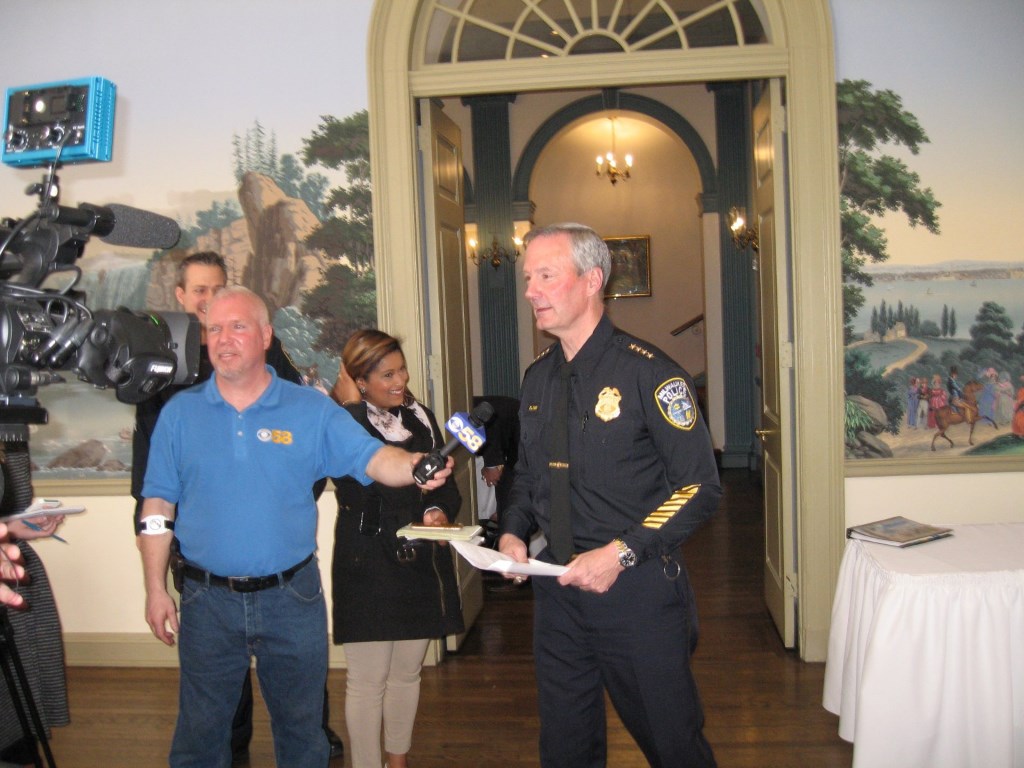
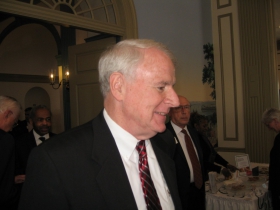

![Chief Flynn [l] Chief Flynn [l]](https://urbanmilwaukee.com/wp-content/gallery/temp/thumbs/thumbs_img_0754.jpg)
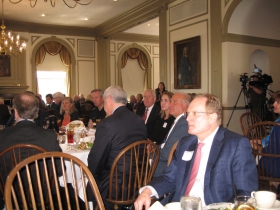
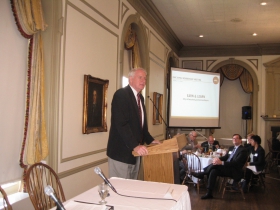
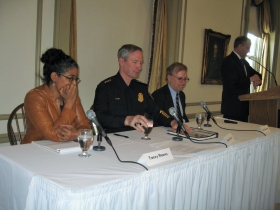




















Sorry…i only made it a few paragraphs in. One line Barrett gives a life experience that a cop told him he would blow his brainsout and aalmost right after that anoyher person talks about police interaction.
So what is it? Do cops and parents need to be tougher or does everyone need a hug?
Milwaukee’s homicide rate is 250 per 100,000 people. According to the Journal-Sentinel, Milwaukee had 145 homicides last year. While that’s a lot, it’s nowhere near 250 per 100,000 people; it’s not even 25 per 100,000.
I don’t know where to start with this article. The homicide numbers that were cited, according to the Journal Sentinel, were for a five-year period. From the JS: “During the conversation, Flynn also dropped eye-popping numbers related to the 53206 ZIP code. The area, he said, is well-known for its high rate of incarceration, but less known for its staggering homicide victimization rate, which he placed at 250 per 100,000 people during a five-year period from 2008 to 2012. The rate for the entire city was about 14 per 100,000 people during the same period. The rate was calculated using the five-year total number of homicides, instead of averaging the annual rate.”
Tom, my thoughts exactly. The murder rate is STILL lower than it was in the 1980s.
Also, any discussion about the increase in crime that omits Dontre Hamilton being shot 14 times by a Milwaukee police officer is not going to be productive.
D’nardo
I believe the 250 per 100,000 was if you take the homicide/death from violence from the 53206 zip code and translate the numbers to a population of 100,000.
The cited homicide statistic was over a five-year period in one zip code–53206.
From the Journal Sentinel article — very different homicide numbers that suggest the rate noted here is a MISQUOTE: “During the conversation, Flynn also dropped eye-popping numbers related to the 53206 ZIP code. The area, he said, is well-known for its high rate of incarceration, but less known for its staggering homicide victimization rate, which he placed at 250 per 100,000 people during a five-year period from 2008 to 2012. The rate for the entire city was about 14 per 100,000 people during the same period. The rate was calculated using the five-year total number of homicides, instead of averaging the annual rate.” http://www.jsonline.com/news/milwaukee/flow-of-milwaukee-teens-to-troubled-lincoln-hills-continues-b99704610z1-375325961.html
Please correct this enormous inaccuracy! 14 per 100,000 vs. 250 per 100,000 is a LARGE mistake!
Legalize and regulate drug consumption as a health issue and suddenly these losers will have a lot less things to murder each other about.
It’s interesting that Barrett had nothing to say every time Donovan sounded off on the spike in crime….yet now that he’s safely re-elected Mayor all of a sudden he notices crime.
This article provides additional support for the argument that guns, like cigarettes, need to be treated as a matter of public health; highly regulated, highly taxed, and if you own one, your health insurance is more expensive. And that’s just the beginning.
Jill you need to check your reading comprehension and listening skills. Barrett has talked about crime in Milwaukee frequently. He just also talks about other issues. Don’t believe everything you hear on talk radio.
This is from August 2013: http://www.pbs.org/video/2365067403/
He talked about it in his State of the City Address in 2015: http://uwmpost.com/news/the-state-of-milwaukee-mayor-tom-barrett-gives-annual-state-of-the-city-address-highlights-social-programs-and-infrastructure
He talked about it in Sept. 2015: http://wuwm.com/post/milwaukee-mayor-police-chief-argue-mandatory-minimum-sentences-some-gun-crimes#stream/0
All occurred before the recent election, and there are tons of additional examples.
I totally agree that the solution is to legalize drugs and address the problem of drug abuse as a health issue. There would be far fewer turf wars and homicides if people weren’t selling drugs on the street corners.
@Jo (#12), there’s been a lot of reporting that most homicide victims in the most troubled areas of MKE are people who know each other and chose to settle some argument with a gun. Are they all “turf wars” over drugs? I doubt it. Just as many were disagreements over a male or some other petty thing. Drugs are a problem, but there’s a whole host of personal responsibility, mental health (anger management), access to guns and lack of jobs problems that need attention too…the soundbite of “gangbangers on the street corner blowing each other away” is just a little too convenient of a way to brush off the real problems.
@Rich (#13) Thank you for your thoughtful response. I would like to see an analysis of the homicide statistics in Milwaukee. It bears further research.
Rich (13), Guess how they know each other and guess what their argument is about? Nobody said every homicide in the city is over drug-related gang warfare, but do you deny that many of the homicides are? Seems to me that unless you have a strong moral objection to legalizing drugs and treating them as a mental health issue that you should be in favor of at least giving that a try, considering that our attempts to cure the issues of “personal responsibility, anger management, access to guns and lack of jobs” seem to have utterly failed.
RE: Flynn citing ‘concealed carry’. Isn’t it amazing how communities such as Hartland, Germantown, Hubertus, Grafton, West Bend, etc. have the exact same gun laws as these so-called ‘third world’ neighborhoods in Milwaukee, and yet they somehow seem to avoid the rampant carjackings, murders and similar behavior?
No it isn’t amazing at all. Those communities have crime and aren’t perfect and are also nowhere near the size of Milwaukee. It’s an absurd and idiotic comparison.
All you get on this site is a bunch of apologists for the bad leadership of Milwaukee. Ask Frankovis, he has plan plus they are 250 coppers down. All these public employees on this site are sucking up all the money.
When will people start taking responsibility for THEMSELVES???
No matter how bad it is though, people in these zip codes are having children. No education, violence…hmm, let’s start having children at 14 years old by different fathers and not just one child, but as many as the reproductive years allow. All of them set free with no parenting. I bet all of the people in the 53206 zip code have similar dna. And people are wondering why there’s all the poverty and violence? Duh! Most of the time these people don’t have the mental capacity to take responsibility for themselves, yet they are adding more people to the tax burden of the responsible people working and paying taxes.
Jerry I want to get you a present. What size hood do you wear?
I’m a little confused by the numbers they’re claiming over the last 20 years. The MPD for many years had been misreporting violent crimes to the FBI either by because of political misconduct or computer glitch. Violent crime, drug gangs and drug dealing are up in huge numbers. They call I-94 between Milwaukee and Chicago Cocaine Lane, even though they carry all illegal drugs. Between drugs, violence and broken homes, there’s no chance for that area to recover if nothing changes. No business is going to move in and create high paying, low skilled jobs. To clean that area up will require a huge increase in police on those streets. Criminals don’t like having cops around. It’s bad for business… It’s too bad the city didn’t fund those 300 unfilled uniformed or those 150 unfilled detective positions on the MPD.
As far as the claims of conceal carry being the problem, Flynn is wrong. Those people doing the shootings shouldn’t have guns in the first place. Most have/had multiple felonies preventing their possession of firearms. You want a safer city? More police and let the criminals serve their time. Just recently a judge with the DA’s support released someone into a monitoring program. In the time he was free, he cut the ankle monitor off, shot two people and was in a car chance causing injuries, with officers. Do the crime, do the full time.
Vincent, Urban Milwaukee is generally an excellent forum for having real discourse about many controversial subjects. Instead of just calling Jerry a racist, you could actually try explaining to him some of the challenges of the culture in the inner city. Not everything he is saying is completely false… he just doesn’t understand that just because those issues are more common than the burbs doesn’t mean it’s the majority of people who live there. I’m guessing he’s pretty clueless on the context of the plight of the inner city and the history of how it became that way too.
Maybe he won’t listen, but other people who read these articles and the comment section might listen.
AG, Urban Milwaukee is generally an excellent forum for having real discourse about many controversial subjects. Instead of just calling Vincent out for accurately characterizing the statements made by Jerry, you could actually try explaining to Jerry some of the challenges of the culture in the inner city. What Vincent said is not false, he’s just frustrated with the racist ideology espoused by many people who avoid the city and complain about it with impunity. Of course it doesn’t mean that majority of people who live in the suburbs are racist, they’re just clueless regarding the plight of the inner city and the history of how it became that way.
Maybe he won’t listen, but other people who read these articles and the comment section might.
Jo Walston, that’s a fair about play. I’ve said the same things to both sides.
I’m sure you have. I meant no disrespect. This is a very complicated issue with no easy solutions. We must be civil when we discuss it. Your point was important.
AG you make fair points and I appreciate what you’re saying. But at this time, after so many months of WCD, I don’t have much will to try and reason with someone who posts something like that. I guess I’m picky about who I try to have a discussion with. Jerry’s post just reads straight-up racist to me, and not like the words of someone who wants to engage.